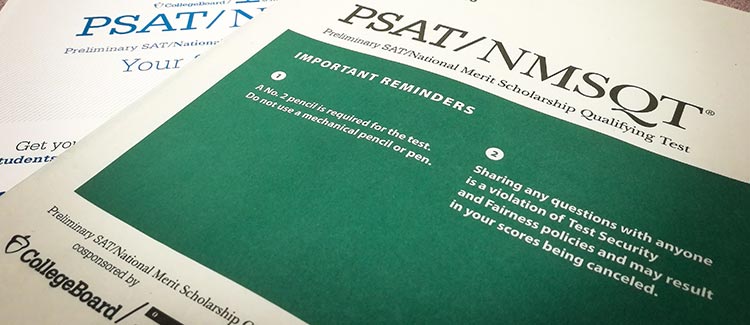For many students, the PSAT is the first formal step on the trek toward college. The test provides a taste of what it’s like to take the SAT, and it can help students strategize as they think about their college applications. And when students take the PSAT/NMSQT during their junior year, they can qualify for scholarships, including the highly selective National Merit Scholarship Program.
What is the PSAT?
The PSAT is a preparatory test for the SAT with four focus areas: reading, writing, language, and math. Students can use their scores to think strategically about where they will apply to college.
For some students, the PSAT can also mean access to scholarship opportunities. There are three different versions of the PSAT. The PSAT 8/9 is relatively new and designed for eighth and ninth graders. The PSAT 10 and the PSAT/NMSQT have the same content, but only the PSAT/NMSQT can lead to scholarships through National Merit and other providers. While students can take the PSAT/NMSQT before eleventh grade, only their score in eleventh grade can qualify for National Merit and other awards. The PSAT 10 is also offered more frequently than the PSAT/NMSQT: twice a year rather than only once. Students can take the PSAT 10 in the fall of tenth grade to see what they need to work on, and can even measure their progress by taking it again that spring before taking the PSAT/NMSQT in the fall of eleventh grade.
Who should take it?
One of the best things about the PSAT is that it’s a very low-stakes test. “It’s perfectly fine if [students] don’t score well,” says Lauri Benton, senior director for college counselor engagement at College Board. “That’s one of the benefits of the PSAT.”
The PSAT helps students identify their strengths and create SAT study plans. Students can use College Board’s free SAT practice site, created in partnership with Khan Academy, to see a personalized SAT preparation plan based on their PSAT scores. However, students don’t need to take the PSAT to get a personalized practice plan — all they have to do is take a few free online quizzes instead.
When used strategically, the PSAT can be a helpful tool for college-bound — and potentially college-bound — students. Dana Plunkett, director of guidance at Wellesley High School in Massachusetts, says the PSAT can help students realize possible pathways they had not considered before. It can also help them decide if the SAT is the right test to take, even if they had planned on taking the ACT. Wellesley High School offers both the PSAT and the PreACT — an ACT preparatory test. Taking both tests, Pluckett says, can help students decide which test they will score better on and are more comfortable taking. She says students might be surprised which test ends up being right for them.
While taking the PSAT (or the PreACT) has some advantages, it really isn’t a “must”. Eileen Blattner, chair of the guidance department at Shaker Heights High School in Ohio, says that ultimately, deciding to take the test is personal. “It’s a decision for students and their families,” she says.
Registration
Most schools offer the PSAT and students can typically sign up through their college counselor. However, if your child is homeschooled or if your child’s school does not offer the PSAT, your child can register to take the test at another school. You can use College Board’s School Search tool to find a nearby testing site. To register, College Board recommends contacting nearby high schools as early as possible to ensure that your teen gets a spot.
Timing the test
Students should be sure to take the PSAT/NMSQT in 11th grade if they are interested in qualifying for the National Merit Scholarship or any other scholarships offered through the test.
While students can take the PSAT 10 or PSAT/NMSQT at any time in high school, Plunkett recommends against taking either test before 10th grade to avoid burnout. “From our opinion, [freshman year] is too soon,” she says. “We don’t want kids taking these tests five or six times. That creates diminishing returns.”
There are many different PSAT pathways students can choose from depending on how much they would like to prepare. Here are three SAT action plans students could take.
Option 1: Start by taking the PSAT in 8th, 9th, or 10th grade
Early starters can begin by taking the PSAT 8/9 in the fall or spring of eighth grade, progress to the PSAT 10 in 10th grade, and study throughout the year using Khan Academy. To monitor progress, they could even take the PSAT 10 again in the spring of 10th grade prior to taking the PSAT/NMSQT the fall of junior year. They can then take the SAT in the spring of junior year and take the test again the next fall if they want to try to boost their scores.
Pros: Students will know exactly what to expect when they take the SAT. Following a highly-focused study plan dedicated to improving on weaknesses is proven to increase SAT scores.
Cons: This could lead to testing burnout and unnecessary stress. Focusing on the SAT can lead students to neglect the ACT, which might be more aligned with their skills.
Option 2: Take the PSAT in 11th grade
Many students are first exposed to the SAT through the PSAT/NMSQT in 11th grade. Students who take the PSAT in 11th grade will still have lots of time to study strategically for the SAT based on their strengths and weaknesses. If students decide the SAT is the right test to take, they can link their PSAT scores to a Khan Academy account to create a personalized study plan, take Khan Academy practice tests to monitor their progress, and take the SAT in the spring of junior year with the option of taking it again the next fall.
Pros: This plan makes sure students will have time to study for the SAT, but limits test prep to a shorter timeframe so they’re less likely to burn out.
Cons: Some students might want to start preparing earlier, especially if they want to boost their PSAT scores in 10th grade to increase their odds of qualifying for National Merit and other scholarships as a junior.
Option 3: Skip the PSAT
Students who want to limit the tests they take can skip the PSAT altogether and take the SAT in the spring of junior year. They can take it again in the fall of senior year if they want to try to improve their scores. These students can still study for the SAT with a personalized plan through Khan Academy or other test prep programs — they’ll just need to take an online practice test to determine strengths and areas of improvement.
Pros: It limits the number of tests students take. It’s a less stressful approach and limits burnout.
Cons: Students miss out on potential scholarships by not taking the PSAT/NMSQT as a junior. Students won’t get to experience a formal SAT testing environment before taking the test. Students are less likely to find out if they’d be better off taking the ACT instead.
If taking the PSAT is the right choice for your teen, then experts have the same advice about prepping for the test: relax. Make sure your teen gets a good night’s sleep, eats breakfast, and thinks of the test simply as helpful practice.






